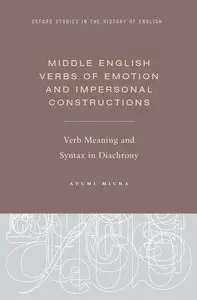Middle English Verbs of Emotion and Impersonal Constructions: Verb Meaning and Syntax in Diachrony by Ayumi Miura
English | 2014 | ISBN: 0199947155 | 312 pages | PDF | 3 MB
English | 2014 | ISBN: 0199947155 | 312 pages | PDF | 3 MB
Impersonal constructions in the history of English form a puzzling category, in that there has been uncertainty as to why some verbs are attested in such constructions while others are not, even though they look almost synonymous. In this book, Ayumi Miura tackles this under-discussed question with special reference to verbs of emotion in Middle English.
Through a careful study of the behaviour of impersonal and near-synonymous non-impersonal verbs, she identifies the factors that determined the presence, absence, and spread of impersonal usage with the verbs concerned. Miura utilizes modern linguistic approaches, including theories and methodologies adopted in the study of psych-verbs in modern languages, which bear close relevance to impersonal verbs of emotion but have traditionally been researched separately. She also draws on categorizations in the Historical Thesaurus of the Oxford English Dictionary and harnesses the online Middle English Dictionary in a novel way, demonstrating that dictionary materials are in fact a valuable tool in the study of early English syntax and semantics.
Miura concludes that a range of factors - such as causation, transitivity, animacy of the target of emotion, and duration of the emotion - influenced the choice of impersonal constructions with Middle English verbs of emotion. We can therefore make reasonable generalizations about when impersonal usage was licensed in these verbs. This careful analysis of the correlation between Middle English verbs of emotion and use or non-use in impersonal constructions represents a new empirical and theoretical contribution to the busy research area of impersonal constructions in the history of English.



